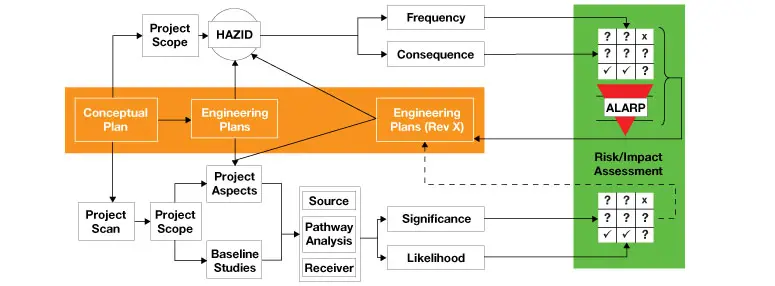Defining the significance of potential impacts in an Environmental and Social Impact Assessment (ESIA) is compromised by a poor understanding of what is likely to happen. The likelihood that an impact will be realised is not absolute; many factors ranging from inherent design features to operational management actions can alter the probability of negative impacts being realised. Being aware of the variable likelihood of potential impacts creates a significant opportunity for mines to save money and operate more efficiently.
Although many mines prepare Hazard Identification Studies (HAZIDS) and HAZOPS (Hazard and Operability Studies)], they are rarely used to support the ESIA process. This leads to less than optimal mine design, unnecessarily stringent approval conditions and, ultimately, to less effective environmental management during construction, operation and closure. Risk assessment cannot replace good ESIA, but it can make impact assessments, and the Environmental Management Systems (EMS) developed , significantly more effective. Risk assessment provides these key indicators:
• Identifies hazards which can potentially lead to consequences (impacts) with a defined likelihood of occurring (realised risk)
• Quantifies risks to alert management to allocate resources based on priority
Since most engineering designs are made to predefined standards, which themselves are based on levels of confidence or risk assessment, the risks identified in the engineering process are readily available for use in the ESIA. Knowing how likely a consequence might be provides impact assessors and engineers with the opportunity to refine designs to reduce risk to a level which is either tolerable or acceptable. Risk assessment matrices frequently include a financial calibration axis, which allows the cost of environmental impacts to be quantified. Knowing how much the potential environmental impact will cost makes it possible to set priorities, allowing operational management to make financial provision to avert or minimise negative consequences.
The largest challenge in using risk assessment as a support to ESIA is making sure ESIA practitioners know how to use the information and regulators know how to interpret it. SRK is increasingly using risk assessment on projects and working with regulators to define the level of impact, which can be tolerated and how best to monitor and manage it on an ongoing basis. Development without impacts is impossible, but with ESIA and risk assessment, operational management can carefully manage and constrain impacts to a tolerable level.
By assessing the impacts in terms that engineers can relate to, the environmental consequences are more likely to be averted as the disconnect that frequently occurs between the disciplines is reduced. SRK is currently applying this methodology on two proposed new mine developments, one in a drought-prone region of West Africa and one in the frozen tundra of northern Canada.

